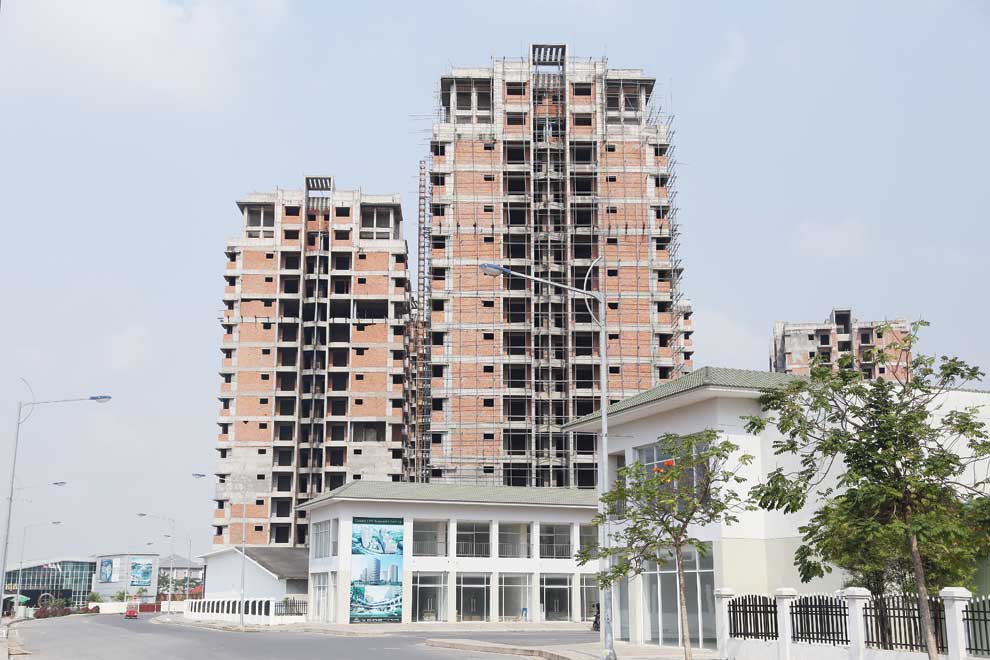
A motorcycle passes in front of construction at the site of Aeon Mall II in Sen Sok district yesterday. The 151,000-square-metre shopping complex is scheduled to open later this year. Hong Menea
Sales have matched the furious pace of residential development in the capital’s Sen Sok district, where new infrastructure and international-class amenities mean residents no longer have to travel across town to find what they are looking for.
The opening of new large-scale residential developments and world-class retail projects is changing the face of Sen Sok, once a ramshackle suburb of Phnom Penh and now on course to becoming one of the capital’s pre-eminent residential districts.
Po Eavkong, CEO of Advance Real Estate, said the district has benefitted from the construction of new infrastructure and opening of large government and private institutions in recent years, as well as new retail opportunities. New roads, international schools, hospitals and the scheduled opening of Aeon Mall II later this year, have drawn predominantly middle class and wealthy Khmer families to Sen Sok district, which Eavkong said is on a trajectory to become an upscale residential neighbourhood similar to Boeung Keng Kang 1 (BKK1).

“Many people sold their homes in the centre of Phnom Penh to purchase homes in Sen Sok district because housing here is much more attractively priced than in the heart of the capital and the district has a growing variety of amenities similar to those found in BKK1,” he said.
Formerly part of Kandal province, Sen Sok was incorporated into the capital in 2009 and covers 59 square kilometres bordered by Meanchey, Por Senchey, Tuol Kork, Russey Keo and Prek Pnov districts. The population has grown rapidly over the last decade and the district is now home to more than 160,000 residents.
Most development has been along a north-south corridor parallel to Hanoi Boulevard and bookended by two large-scale urban development projects, Camko City and Grand Phnom Penh. Eavkong said property sales in this area have picked up in recent years, and finished residential projects are now about 70 to 80 percent physically occupied. More projects, especially boreys (gated residential communities), are currently under construction.
“Within the next five to 10 years, from Camko City to Grand Phnom Penh, where there used to be lakes, will become an extremely developed zone,” he said.

A project under construction in Phnom Penh Thmey commune, Sen Sok district. Hong Menea
According to Eavkong, undeveloped land prices along main roads that intersect Hanoi Boulevard have increased by an average of 10 percent in the last year and now range from $200 to $600 per square metre. Prices have climbed even faster along Road 1003 near Aeon Mall II and Makro, where residential properties are now fetching between $2,000 and $3,000 per square metre – about half the price of comparable units in BKK1.
Sorn Seap, director of Key Real Estate, said property transactions in Sen Sok district slowed slightly last year after five years of intense activity. Sales of new residential projects such as Borey Pibhub Thmey, Park Land Sen Sok and Arata Garden Residences have improved. However, sales in Camko City and Grand Phnom Penh – two of the earliest and biggest projects in the district – appear to be moving slowly.

Residential units in Camko City. Hong Menea
According to Seap, very few new residential projects have been announced lately, but many of the existing ones are expanding. He said the launch of warehouse club Makro in December, and the expected opening of Aeon Mall II later this year, have greatly enhanced the district’s appeal to home buyers and the retail giants are expected to draw even more new residents to the area.
Phou Sambath, marketing manager of real estate developer Borey Phnom Penh Thmey, said his company has invested in seven residential projects in Sen Sok. Six of the projects have already sold out and the seventh is “moving forward very quickly.”

Makro opened its first store in Cambodia in December. Hong Menea
“Sen Sok is in a very good location, and so Borey Phnom Penh Thmey has launched many projects there,” he said, adding that the district now has all the amenities that once required a trip to other parts of the city.
Chea Sokheng, marketing supervisor of Chip Mong Land, which is developing the Park Land Sen Sok project, said the district has strong potential for borey developers. He said the flurry of development has brought international brand cafes, shopping malls and international schools, as well as an exhibition centre.
“The local residents of Sen Sok will find the location convenient as they do not need to travel far anymore,” he added, adding that in many ways the district is evolving into “a second BKK1”.

Unfinished condominiums in Camko City. Hong Menea
According to research by Key Real Estate released in February, the highest land prices in Sen Sok district are currently in Teuk Thla commune, where plots along Russian Boulevard are selling at between $2,000 and $3,000 per square metre, and between $800 and $2,000 on smaller roads. Prices in other communes range from $100 to $1,300 per square metre, except in Phnom Penh Thmey commune, where prime real estate along main roads in fetching up to $2,500 per square metre.












